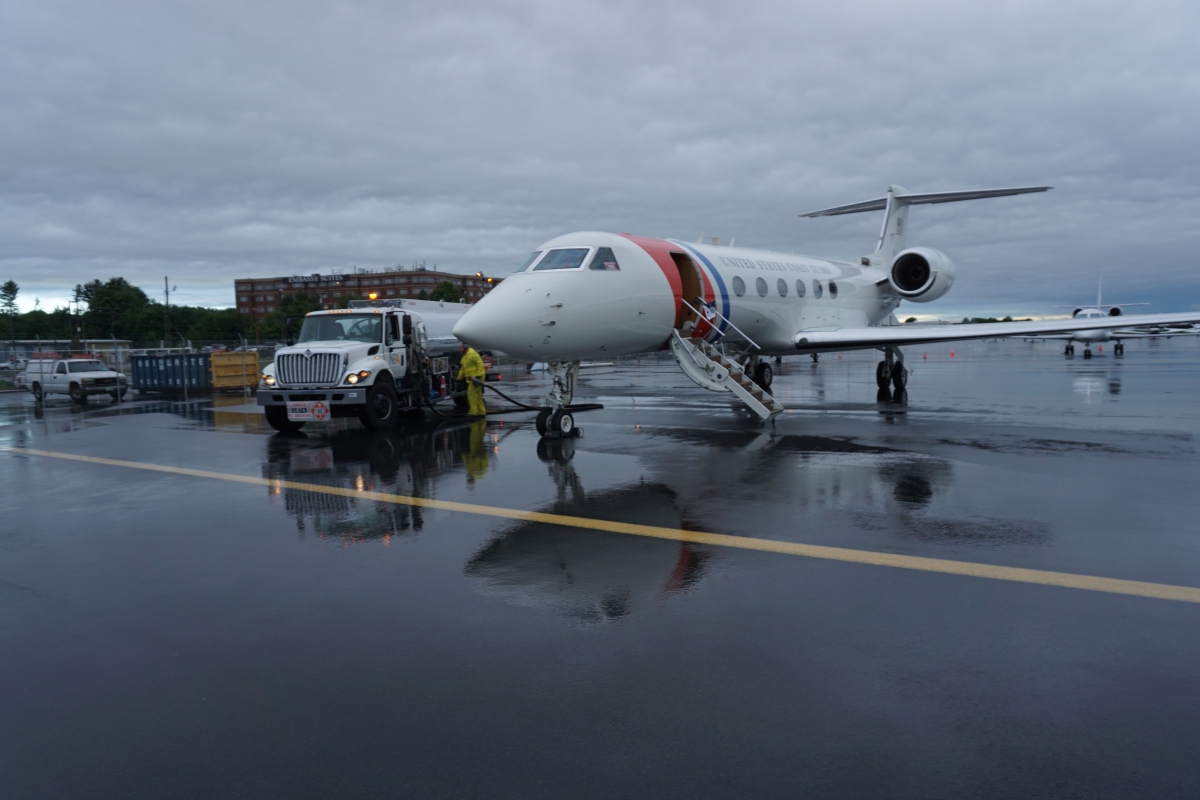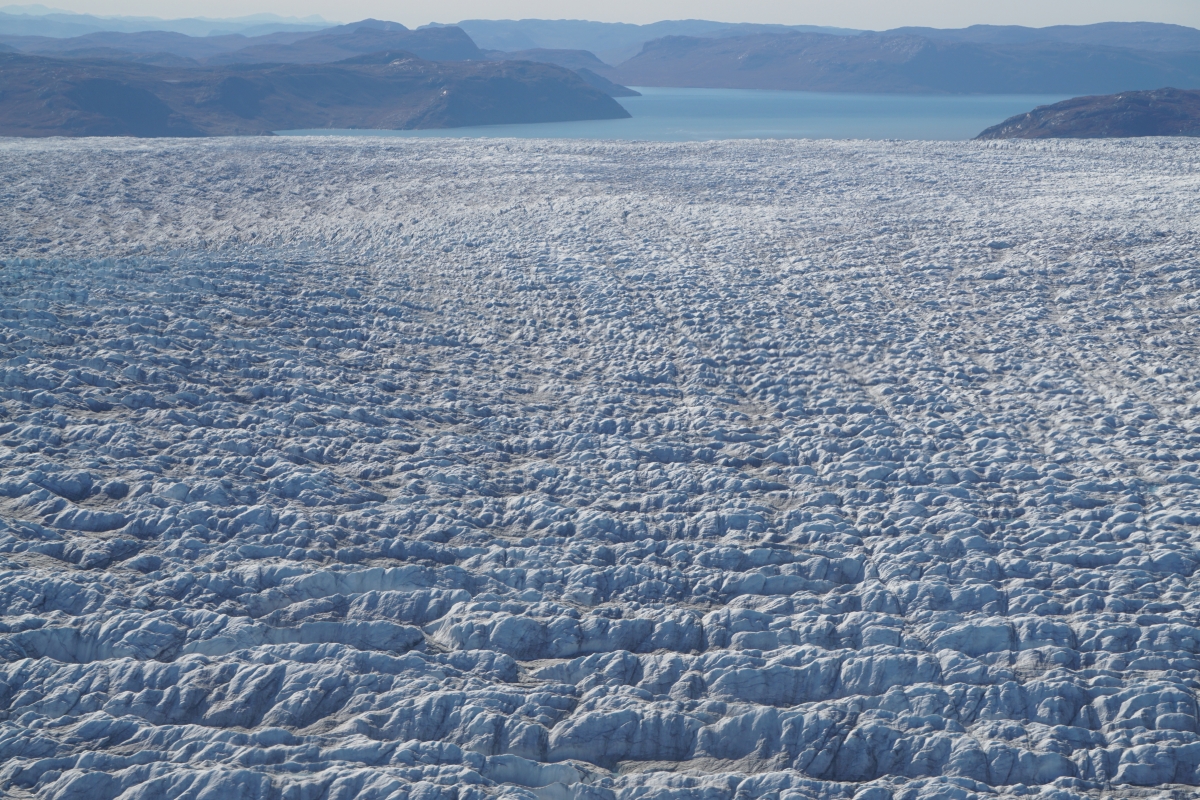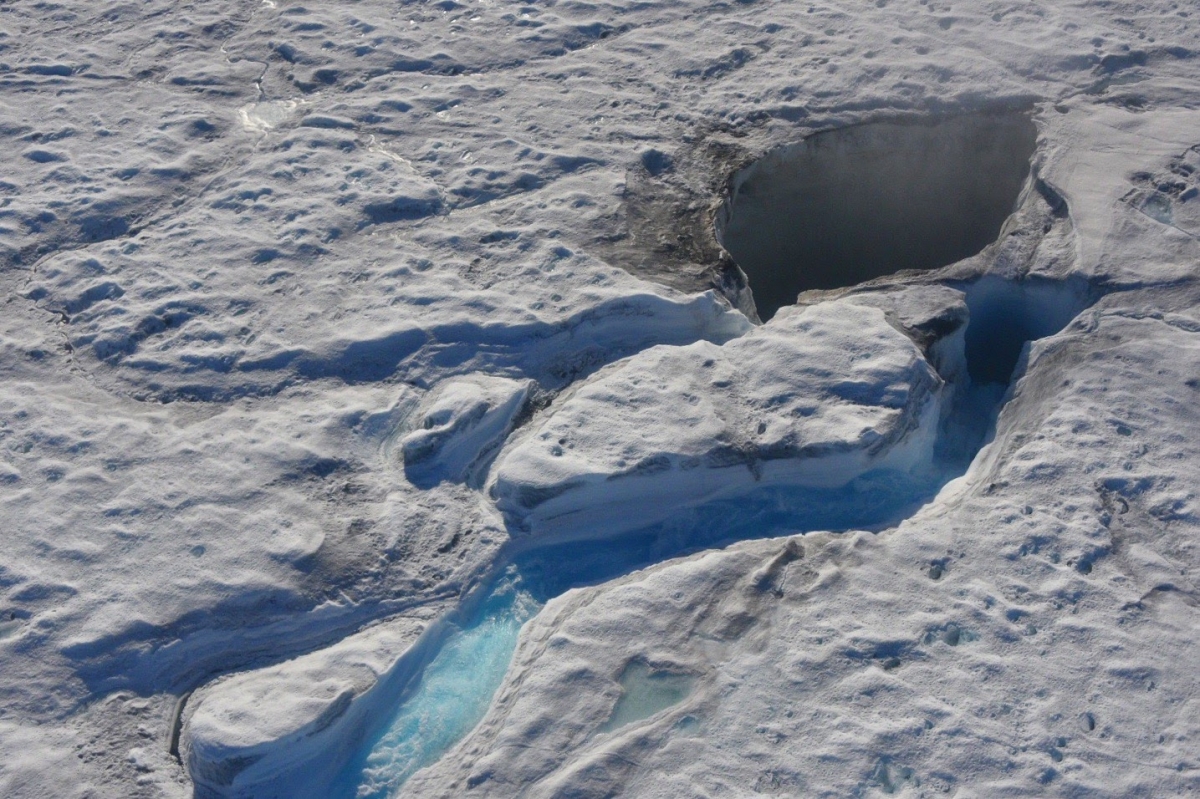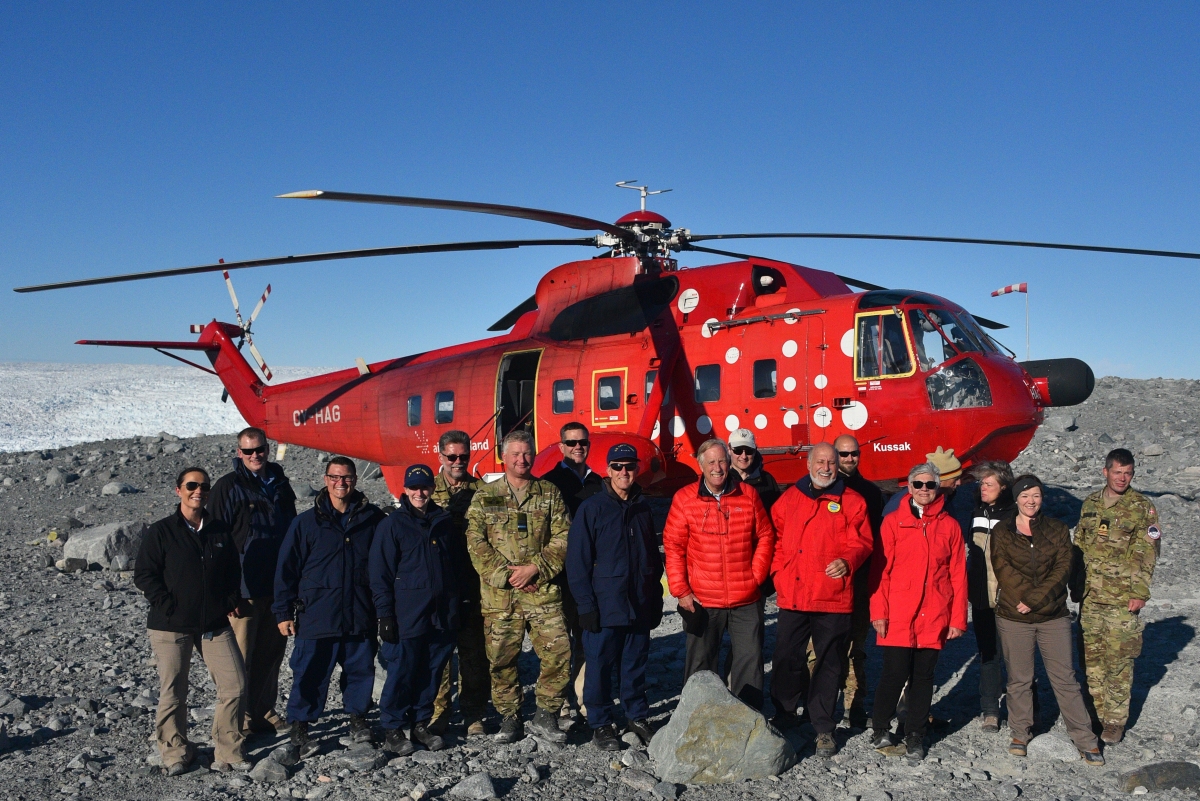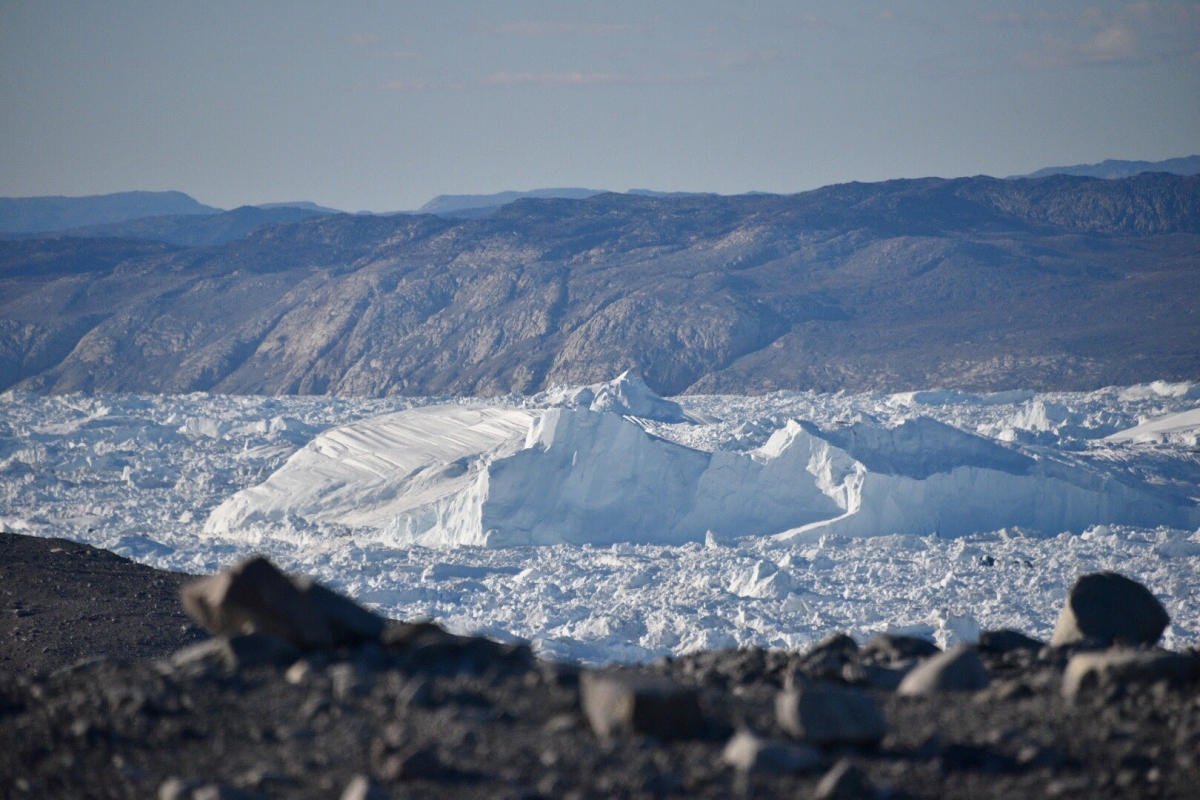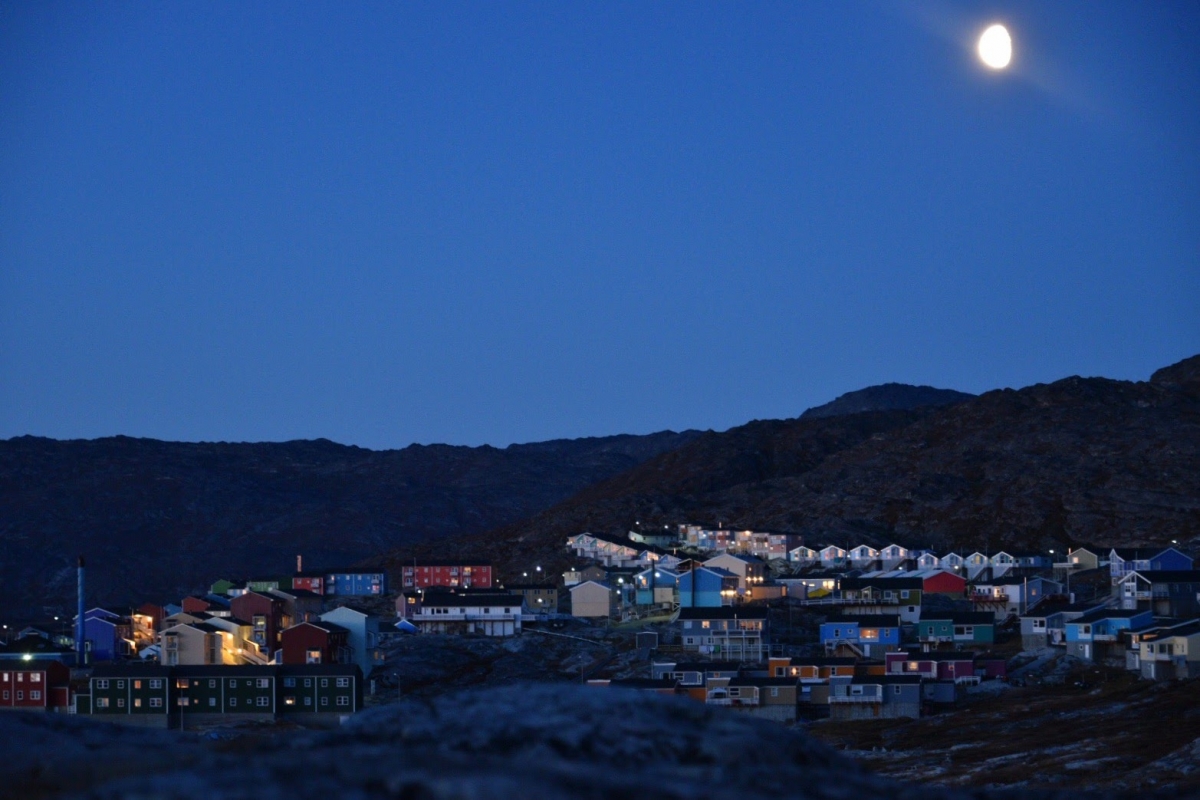Greenland is Getting Greener – Part 1 from our Fact-Finding Trip
 I have just returned from a Fact-Finding trip to Greenland with the US Coast Guard (USCG) and Senator King that was powerful for all the participants.
I have just returned from a Fact-Finding trip to Greenland with the US Coast Guard (USCG) and Senator King that was powerful for all the participants.
It is too much for a single post, so I am doing this in four parts, each roughly following the days of our visit and the four key issues:
- Part #1 (Today) Greenland is getting greener — and grayer. Changes in recent years.
- #2. Titanic Disasters Ahead? Disappearing Glaciers mean more dangerous icebergs. Opening of sea routes demands particular cooperation from the US, Canada, and Greenland to ensure safety of lives, ships, and the environment
- #3 Greenland will gain usable land area from sea level rise (SLR). It is the only country to do so. Understanding that paradox is a special case to illustrate that global SLR will not have the same impacts everywhere.
- #4 As Greenland Melts, International implications: Cooperation or Conflict? This New Era poses huge challenges for the USCG and their seven counterparts in the other Arctic nations.
With the presence of Senator Angus King from Maine this was officially a Congressional Delegation (“CODEL”). While not intending this to be a travel-log I will give a sense of the logistics as it helps to grasp the scale of Greenland, a place that is so unfamiliar to most people.
Monday morning, I joined the USCG Commandant Paul Zukunft and a few of his Coast Guard Captains and Aides at Reagan Airport in Washington DC — at a distant hangar that serves as the Air Station for the Coast Guard, Department of Homeland Security (their ‘parent’ agency), and the Federal Aviation Administration’s (FAA) own aircraft.

As shown on the map above, Portland is directly on the route of flight to Greenland so it made sense to stop there for fuel and pick up the three passengers. Sen. King was formerly Governor and is now the junior Senator — and in fact a registered Independent (neither Republican or Democrat). His Committee assignments include special focus on Intelligence, Strategic Forces, Sea Power, Energy, and Natural Resources all of which make this trip relevant to his understanding for informed policy decisions. Flight time from Portland to Greenland was about three and a half hours.
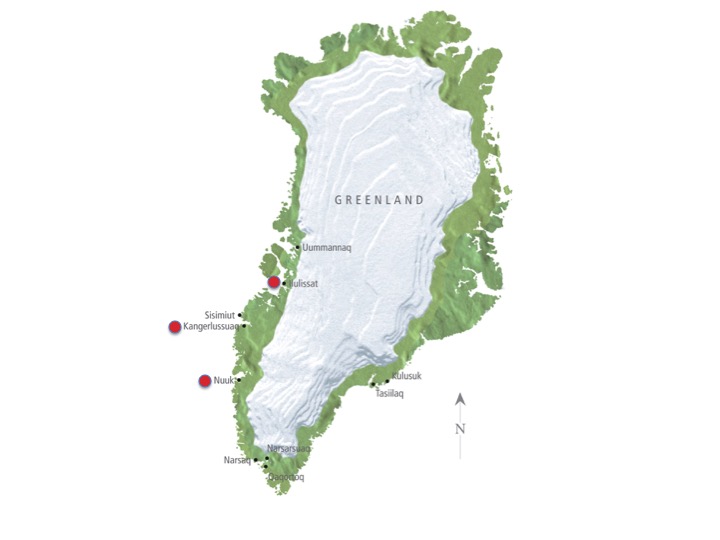
It has long been noted that Greenland seems like a misnomer, since it is almost entirely ice, an estimated 80%, though shrinking. In contrast the much smaller nearby country of Iceland has only 11% ice coverage, due to being a little further south, but benefiting from active vulcanism with abundant geothermal springs and geysers. The inappropriate name of Greenland was not an accident. A thousand years ago, it was essentially a marketing ploy by ‘Erik the Red’ a Viking who was exiled from Iceland as a result of manslaughter. He was luring Norwegians to move to the pristine unclaimed land along the coast that was similar to their native country.
As we approached the huge island — roughly three times the size of Texas — it was obvious that Greenland is getting greener. I could see a dramatic difference since my last visit nine years earlier, at the same time of year. Then the white glaciers were much closer to the coast. Now the ground is covered with lichen and mosses in various colors of yellow, red, browns and yes — GREEN. The multicolored ground cover is interspersed with lots of granite and other rock outcroppings.
About 2 pm local time — 2 time zones ahead of Eastern time — ‘Coast Guard One’ landed in the tiny community of Kangerlussuaq (middle red dot on map to the right) — the only airport on the West Coast with a runway long enough for international flights — we were met by various Danish military and civilian officials representing their Coast Guard counterparts, the Danish Meteorological Institute, etc. Greenland is an independent nation within the Kingdom of Denmark (a similar relationship as Canada and the Bahamas have to the United Kingdom-Great Britain.) Denmark takes responsibility for Greenland’s Military and Coast Guard, given the very small population.
In Kangerlussuaq, we boarded a helicopter to tour the ice sheet, particularly Jacobshavn Glacier (“Yak-OBS-hav-en”) the largest of the hundred or so glaciers that drain the ice sheet — miles thick — that dominates the island.
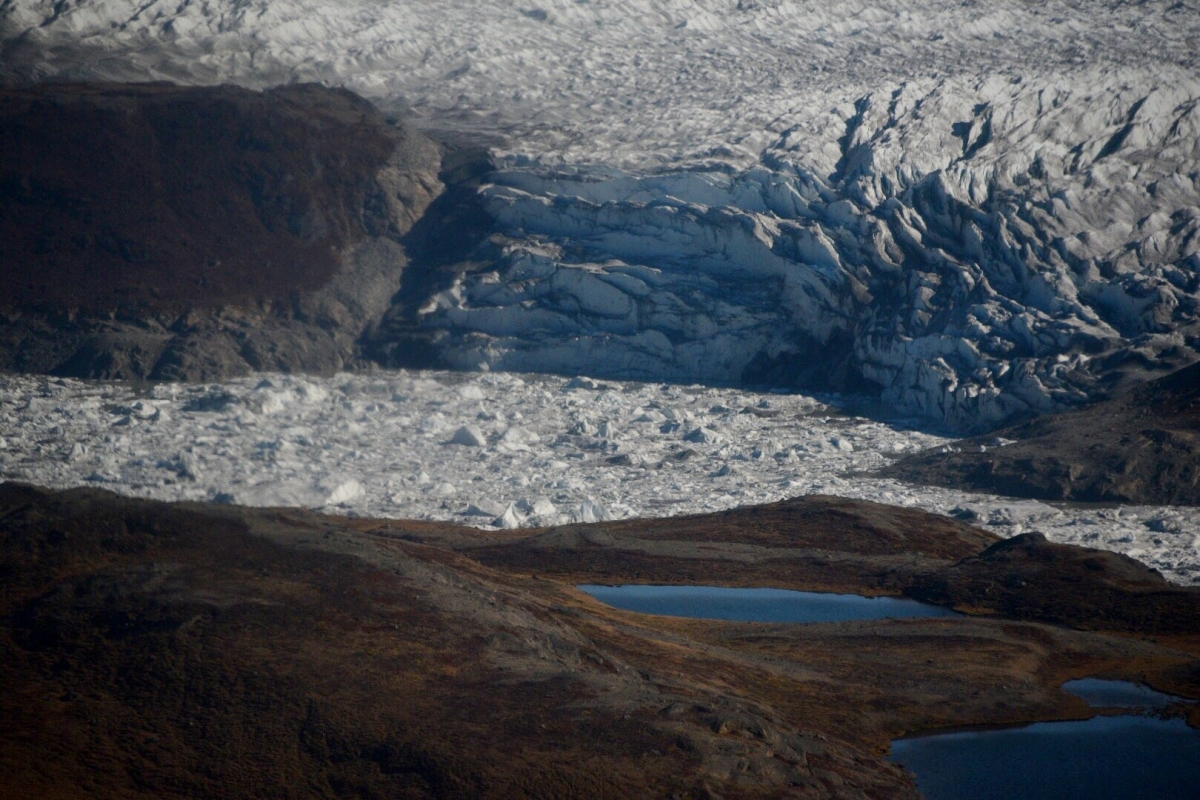
We saw a huge moulin, (far right) one of the more than thousand holes that have developed in the ice sheet in the last decade or so. These vertical chimneys start out as cracks that allow the meltwater on the surface to drain through the thousands of vertical feet of ice eventually getting to the bedrock. There it lubricates and even lifts the ice off the bedrock, causing the glaciers to speed up with double or triple their speed. As the glaciers speed up they spawn more icebergs.
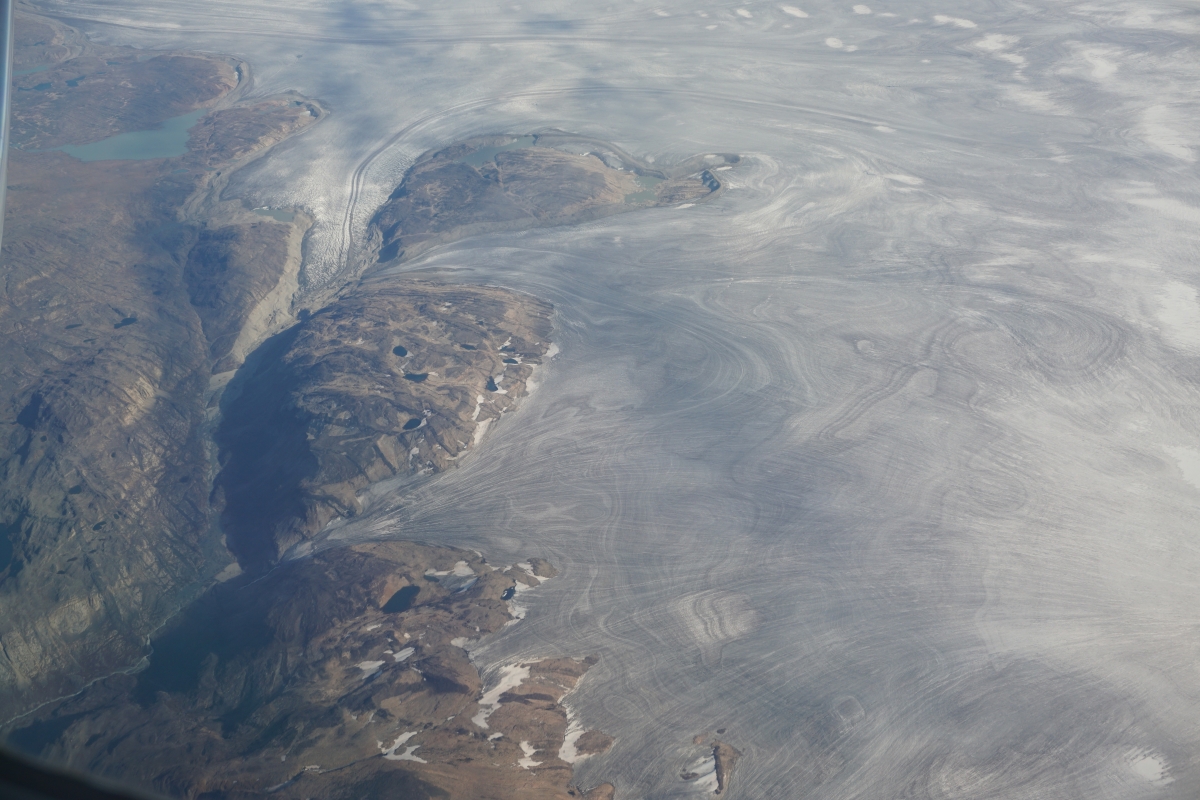
As the glaciers shrink we observed that a new problem is happening. The exposed bedrock and gravel — even very fine dust-like material is blowing over the remaining ice, turning the white various shades of gray. Darker surface absorb more heat than reflecting white surfaces, adding to the melt rate — another feedback loop that hastens the glacial retreat.
Yet to be clear, even at the current advanced rate of melting it will take many, many centuries to melt the Greenland Ice Sheet. That’s important to keep in mind since by itself Greenland holds enough ice to raise sea level about 24 feet (7 meters) globally.
The single Jacobshavn Glacier accounts for 6-7 % of the total annual ice output of Greenland. Given that there are roughly a hundred glaciers draining the ice sheet, the sizse of this single one totally stands out. When it melts entirely, global sea level will be roughy a foot and a half higher (0.5 m) There is considerable debate within the scientific community about how many decades that will take — possibly even centuries.
In part, the number cannot be predicted well, because of the increased warming, which correlates with greenhouse gases (GHG) over longer periods of time.That depends on global energy consumption and how it is produced. But the fact is that the melting rate has increased dramatically over the last century.
We are in a new era. Greenland has been relatively stable for the last several thousand years along with most of the planet. Now the evidence from the drill cores deep into the ice sheet indicates that we are headed to a situation that has not existed for over a hundred thousand years. We see that in the context of the last several million years of repeating ice ages, approximately every hundred thousand years. Now we have broken out of that pattern. By seeing the extreme melting with their own eyes, and our own presentations on location, and conferring with the Danish Meteoroligists, the military, and the Inuit (the “people” of the Arctic that might often be called “Eskimos”) – the Senator and the head of the Coast Guard hope to put another layer of clarity and confirmation on the concept that it is time to plan for a revolutionary reality — that sea level has just started to rise to levels not seen in millennia.
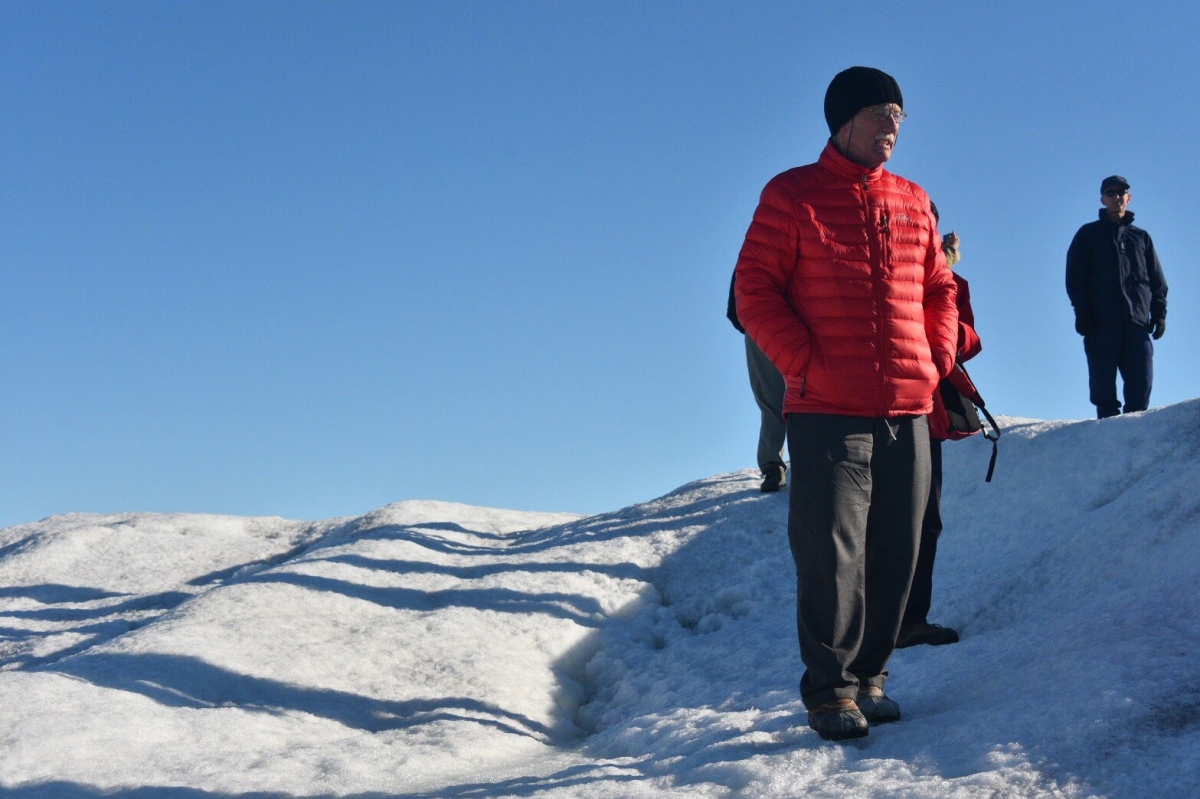
We got out of the helicopter to explore the glacier on the margin, with the rocky boundary.
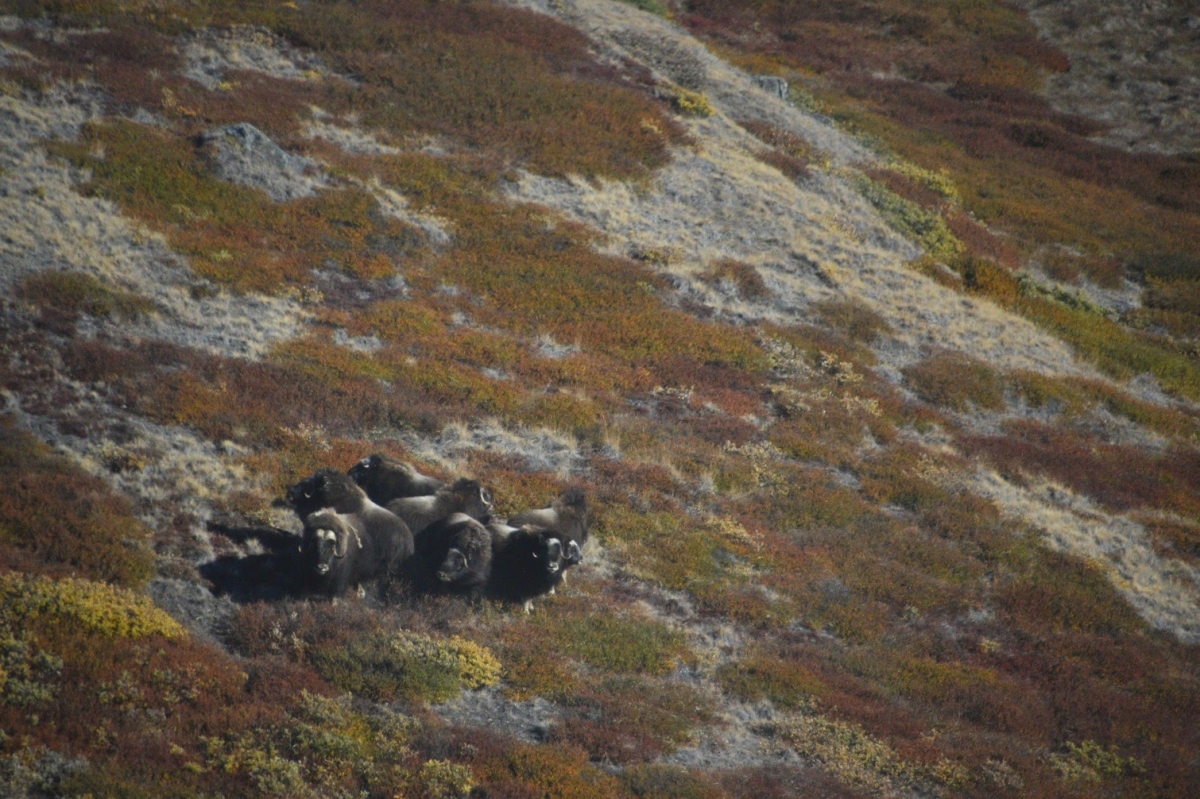
Finally we got back aboard the heli, to continue on to the town of Ilulissat, (Upper red dot on the map above) the third largest town on Greenland. It is at the mouth of the Jacobshavn Glacier, or more properly the Ilulissat Fjord, on the North side.
Flying down the Fjord, it almost looks solid, but this is all floating icebergs and ice, sometimes called “bergy-bits.” Shown above in the center is a large iceberg.
Recall that just like ice cubes in a glass only about 10-15% of an iceberg is above the surface. What hides below is 7 – 10 times larger.
The increased warming is creating more and larger icebergs.
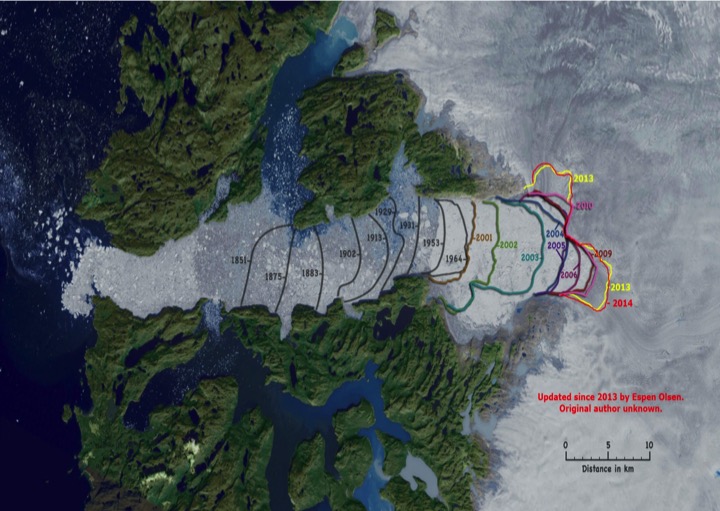
The various lines show the “calving face.” Look carefully at the years starting with 1851 on the far left. As the glacier “retreats” or disintegrates, the calving face — the place where it calves off into icebergs, moves Eastward, or to the right in this image. The brown line about two thirds of the way in, depicts 2001. Note the incredible acceleration in the last fifteen years.
Now the retreat will slow because the glacier is no longer resting on water in the fjord. It has reached the “grounding line” meaning it is now on land. When glaciers are on water they disintegrate much more quickly as they can melt from the warmer water underneath as well as from the warming air on top. Even if water is near freezing temperature it has tremendous heat content compared to the air, due to the far greater density.
The town was formerly known as Jacobshavn, Ilulissat means ‘iceberg’ in Greenlandic, a dialect of Inuktitut, the dominant language of the Inuit (“the people”) of the North Pole region.
We checked into the very nice Hotel Arctic around 8 pm, and ended the long day with a good meal.
Tomorrow, I will cover our trip on the Danish Defense Vessel Thetis, out among the icebergs, looking at implications for shipping, both commercial and cruise ships. My title “Titanic Disasters Ahead?” should give you some idea what to expect.

